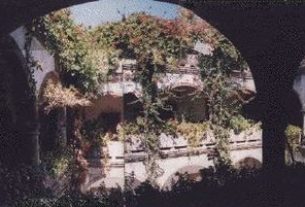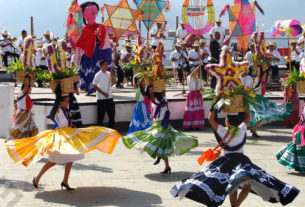Here is the history of Mexico in the last two or three decades – and what a history it is. It’s the story of how a dictatorship eventually found its way toward becoming a democracy. As stories go, this one has everything – political corruption, student demonstrations leading to a massacre, earthquakes, citizen crusades, an Olympics and, as they say, much, much more. It looks as though it might even have a happy ending.
It’s a story that is also beautifully told by Preston and Dillon, a pair of New York Times correspondents who covered the U.S. southern neighbor from 1995 to 2000. In 1998, they were named winners of the Pulitzer Prize for international reporting. In the course of their work they interviewed scores of Mexican newsmakers – presidents, politicians, journalists, students, dissidents and ordinary citizens at all levels. The result as it is presented here is a model of journalistic research.
The political backbone of the story are the seven decades in which the PRI – the Institutional Revolutionary Party – ruled the country and the citizens’ movement that eventually ended this seemingly unstoppable one-party rule in July 2000. There was no trick – dirty or otherwise – that the PRI wouldn’t stoop to in order to retain power. These ranged from assassination to shipping busloads of supporters around the polling booths on an election day to vote PRI in each one even though they weren’t registered there. In some jurisdictions, there were more voters at the end of the day than there were adult residents. Poorer voters were made to mark their ballots in full view of PRI workers. The Party would stop at nothing in order to win an election.
The eventual turnaround began as early as 1968 with a student revolt. The uprising began in the summer of that year with street battles all over Mexico City. Gustavo Diaz Ortiz, president at that time and a real hardliner, wasn’t too thrilled by all the marches and strikes and speeches that were being made against his government. He ordered out the police and the army. Numbering in the tens of thousands, they descended on a huge student protest at Tlatelolco and opened fire. Hundreds of students were killed and hundreds more arrested.
That may have settled the problem for the moment but it also meant the PRI system completely lost legitimacy, not just in the eyes of students but, perhaps more importantly, in the eyes of middle class Mexicans. Large numbers of them began to participate in the anti-government demonstrations. Most commentators regard it as the beginning of the end for the PRI.
As one can imagine, there was a great deal of citizen resentment against PRI personnel and some of the stories of how various citizens reacted are given in these pages. I must admit to being amused by one. “After a fraudulent election in Chemax, Yucatan, a mob of one hundred local men seized a PRI official who had attempted to steal a ballot box and, one by one, urinated in his face.” After reading some of these stories you can well understand their feelings.
Although there is no end of villains, the story is not without a good guy or two – even in the PRI ranks. President Carlos Salinas emerges from the story as someone who at least instituted a few needed reforms. He is the one who played a major role in Mexico’s becoming a part of the North American Free Trade Agreement (NAFTA). As the authors explain: “NAFTA was Mexico’s first bloodless revolution. It brought enormous changes, not only in the alignment of its economic interests but also in the country’s self-perception. The central focus of Mexico’s economy shifted. Businesses producing for export were in, while those that supplied a sheltered domestic market were out.” NAFTA also brought Salinas recognition as a world-class leader.
When Salinas’ six year term was completed, he was to be followed by Luis Donaldo Colosio, another PRI stalwart. However, Colosio was assassinated while campaigning in Tijuana. Ernesto Zedillo was selected by the PRI, with Salinas’ approval, to run for president.
Zedillo had humble beginnings in the Baja and the folklore has it that he even shined shoes in his boyhood in order to help his mother make ends meet. However, he was an exceptional student and graduated with a degree in economics from the prestigious National Polytechnic Institute. One of the positive aspects of the PRI system was that it was possible to get a respectable and almost free education and, with the help of scholarships, Zedillo actually made it to Yale where he finished his doctoral studies in 1978 at age 27.
He doesn’t seem to have been a very charismatic individual but he certainly had his own ideas as to how things should be run, particularly in economics. To quote: “He believed in the virtues of free markets, global commerce and international capital. He opposed protected trade, big government, social patronage and foreign indebtedness. He maintained that sound economic policy required transparent accounting and straight talk from government rather than the PRI’s opaque, clubby rhetoric… Mexico now had a president who was seriously uncomfortable with the gap between declaration and action in the workings of the state.”
On the economic front, there were later events that augured well for the country such as the admission of Mexico as a full member of the Organization for Economic Cooperation and Development. The authors describe the OECD as “a sort of country club of world nations; only aspirants that are up to its income and social standards can get in.”
Non-political events are amply covered in the narrative. For instance, the earthquake that struck Mexico City in September 1985 is vividly described. It had a force of 8.1 on the Richter scale. By a tragic coincidence, it struck the Tlatelolco area of the city, the same area where the student massacre had taken place in 1968. The damage was horrendous. More than 370 buildings collapsed, including the main pavilions of two major hospitals, scores of government offices, the main studios of the largest the network, Televisa, several tourist hotels and the central telephone switching station that controlled local and long-distance telephone communications for the whole city.
Another earthquake struck the following day, not quite as severe as the first one. Hundreds were killed in both quakes and tens of thousands injured. Hordes of homeless refugees sought shelter in public buildings and lean-tos in parks. To make matters worse the government did not cover itself in glory in the clean-up operations. For example, the army troops and police who arrived on the damage scene in Tlatelolco only cordoned off the scene but didn’t join in the rescue work.
This seeming indifference and ineffectiveness only served to further harden citizen attitudes to the PRI and to pave the way for an ultimate change of administration. That was at least a positive aspect of the quake. Citizen groups were formed and the poorest of the poor joined with their middle-class neighbors to work on the recovery. At the same time a new and more civil society emerged.
But even in the final days of the PRI administration in 2000, there was still a possibility they might win yet again. Zedillo was popular and the economy had grown 6.9 per cent in 1999. Also, a move toward uniting all the opposition parties behind a single candidate had collapsed. However, Vicente Fox, leader of the PAN (Partido Accion Nacional) was gathering strength. In 1997, many leading businessmen were openly declaring their support for him and – more importantly – making donations to the PAN. A previous peso crisis was one of the turning points in their thinking.
Fox was elected on July 2, 2000. Even though it looked as though they had won, the PAN supporters still kept up their guard, ever ready for PRI dirty tricks like disrupting polling booths and destroying ballots. But it was a day with a happy ending – it saw the cleanest and most open voting in Mexican history.
One of the by-products is that Mexico now has one of the most sophisticated voting systems in the world. Nearly half a million people have been randomly chosen from all registered voters to serve as polling-place officials. They are backed up by opposition poll watchers covering all the 113,000 balloting places. One innovation in the process is a skinny little polling booth that can’t possibly hold more than one person, with a curtain that allows each voter complete privacy.
There’s much much more to this splendid book. For instance, remember the Zapatista uprising, where rebels under Subcomandante Marcos fought for Indian self-determination inside the Mexican state. It was a mid-’90s event that’s well covered here. So, too, are the 1968 Olympics in Mexico City – in Tlalulco of all places.
Then there’s Chapter 13, The Ear Cutter ( El Mochaorejas), which covers a period when Mexico was hit with a huge crime wave. I found it a genuine mind-boggler. As one well-known editor wrote at the time: “Hearing crime stories over meals had become a dismal routine in Mexico City.” Many hosts were establishing a rule, and only partly in jest: each guest was entitled to tell of only one mugging, car theft, or other attack. Another writer asked the question: “How had one of the safest countries in the hemisphere become a place where bullet-proofing automobiles was a growth industry?”
Police were only a part of the problem. A 1988 study by two Mexican sociologists found that young officers were taught techniques of extortion from the moment they entered the police academy. The instructors were even shaking down cadets for payments before they were promoting them on to the force.
“Opening Mexico” is simply a marvelous read. It’s loaded with well-presented information and the story itself is endlessly interesting. After reading about Mexico’s struggles to achieve democracy in recent decades, one can only wish the country well as it continues in its new direction.
Opening Mexico
The Making of a Democracy
By Julia Preston and Samuel Dillon
Oceano de Mexico, 2004
Available from Amazon Books: Paperback


